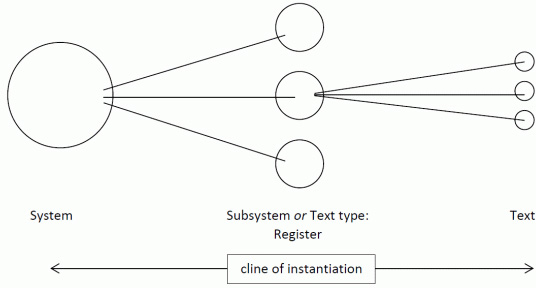Multimodal register is an integration of resources (both semantic and lexicogrammatical resources) typically associated with a certain text type.
The term ‘register’ was originally coined by Thomas B. Reid in 1956 (cf. de Beaugrande 1993) before Halliday included it in the systemic functional apparatus in 1964 (Halliday et al. 1964). Besides Halliday, Ure & Ellis are among the first to expand on Reid’s term; in 1977 they define register as “…a subdivision of a given language, a ’situational variety’ constituted by a selection of choices from among the total linguistic options offered by that specific language” (Ure & Ellis 1977: 198). Halliday defines register as “variety according to use” (Halliday et al. 1964: 77). This definition is to be understood in comparison with dialect, which he defines as “variety according to user” (ibid.: 77). An elaboration of Halliday’s first definition of register is provided in Language as Social Semiotics, where he defines register as “the configuration of semantic resources that the member of a culture typically associates with a situation type” (Halliday 1978: 111). In recent work (e.g. in Halliday’s Introduction to Functional Grammar), Halliday & Matthiessen model register midway on the cline of instantiation, and depending on the perspective, a register is regarded either as a subsystem (seen from the system end) or as a text type (seen from the text end) (Halliday & Matthiessen 2013); this is illustrated below:

For a more elaborated description of the term register and how it has been defined and used in (systemic) functional linguistics, see Matthiessen (1993) and Andersen (2013).
Register has not yet been elaborated much as a multimodal concept. But many discussions regarding the instantiation axis touch on this subject, if only inexplicitly (see e.g. Kress & van Leeuwen 2001, 2006, Kress 2010, Baldry & Thibault 2006). If the multimodal text is instantiated from highly complex systems of multimodal meaning making resources, the register may in correlation to Halliday’s concept of register be seen as functional variants of the semiotic system(s) – in other words as ‘typical’ constellations of resources used for certain communicational purposes, i.e. for certain texts. For instance we might think of a certain type of written text as a constellation of resources that we very often use together – both the more classical grammatical choices and the choices in typography, layout, paper quality and so on. This, however, brings the notion rather close to what may be a (new) way of defining a mode – as a conglomerate of resources that often occur together (see Boeriis 2009 for a discussion of ‘mode registers’).
If we understand multimodal register as an integration of (semantic and lexicogrammatical) resources typically associated with a certain text type that is functional in a given situation, we can pose a number of descriptive questions, i.e. we can describe the resources typically involved in realizing a text type and as such we can approach the register description from several perspectives. From a general perspective we may ask: what resources/traditional modes are involved and what does that mean? From a more integrational perspective we might ask: what roles do the involved modes play and how do the different modes play together? And from a very specified perspective we can ask: what grammatical ‘mechanisms’ are typically instantiated by the interplay of the multimodal resources of the register and how are the meanings realized?
Citing this entry
Andersen, Thomas Hestbæk & Morten Boeriis. 2015. “Multimodal register.” In Key Terms in Multimodality: Definitions, Issues, Discussions, edited by Nina Nørgaard. www.sdu.dk/multimodalkeyterms. Retrieved dd.mm.yyyy.
References
Andersen, Thomas H. 2013. “Registerbegrebet. En teoretisk forankring og et rids over begrebets praktiske anvendelighed til tekstanalyse og tekstforfatning”. In: Hållsten, Stina, Hanna Sofia Rehnberg & Daniel Wojahn (eds.): Text, kontext och betydelse. Sex nordiska studier i systemisk-funktionell lingvistik. Södertörns högskola.
Baldry, A. P. & Paul J. Thibault (2006). Multimodal Transcription and Text Analysis. London: Equinox
Boeriis, M. (2009) Multimodal Socialsemiotik og Levende Billeder. PhD dissertation. Odense: University of Southern Denmark
de Beaugrande, Robert 1993. ’Register’ in discourse studies. a concept in search of a theory. In: M. Ghadessy (ed.), Register Analysis – Theory and Practice. London: Pinter.
Halliday, Michael A.K. 1978. Language as social semiotic. London: Arnold.
Halliday, Michael A.K. & Matthiessen, Christian M.I.M. 2013. Halliday’s Introduction to Functional Grammar. London: Routledge. 4th edition.
Halliday, Michael A.K., McIntosh, Angus & Strevens, Peter 1964. The Linguistic Sciences and Language Teaching. London: Longmans.
Kress, G. (2010). Multimodality. A social semiotic approach to contemporary communication. London: Routledge
Kress, G. & T. van Leeuwen (2001). Multimodal Discourse. The Modes and Media of Contemporary Communication. London: Arnold.
Kress, G. & T. van Leeuwen (2006). Reading Images. The grammar of visual design. London: Routledge
Matthiessen, Christian M.I.M. 1993. Register in the round. diversity in a unified theory of register analysis. In: M. Ghadessy (ed.), Register Analysis – Theory and Practice. London: Pinter, 221-292.
Ure, Jean & Ellis, Jeffrey 1977. Register in Descriptive Linguistics and Linguistic Sociology. In: O. Uribe-Villegas (red.), Issues in Sociolinguistics. The Hague: Mouton, 197-244.